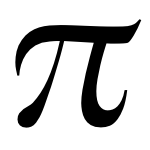 There are plenty of Pi posts here on Grey Matters. If you're really into it, you can even learn 400 digits of Pi!
There are plenty of Pi posts here on Grey Matters. If you're really into it, you can even learn 400 digits of Pi!
Learning the digits are one thing, though. How do we move Pi from the left brain's logical side to the right brain's “big picture” side? In other words, how do we go from memorization to understanding?
Back in January, I posted John Reid's animation, which effectively depicts that Pi is the circumference of a circle divided by its diameter:

If you download the free Mathematica Player, you can download an interactive version for your system. The Mathematica version breaks up the pattern along the radius instead of the diameter, so you may want to compare both versions.
The great thing about this is that, if you took the time, you could actually carry this out as an experiment. It's there that you would run into the next problem. Sure, you might be able to determine Pi to 1 or maybe 2 digits this way, but the question will pop up as to how all the other digits are determined.
To answer this question, NOVA has provided an article on Archimedes' method for approximating Pi. In the article, a visual demonstration is provided. If you have Flash installed, you can try out the interactive version. If not, you can still check out the non-interactive version on the site, or download the interactive Mathematica player version.
Since we have all these digits, what do they mean in practical terms? To find out, let's try a fun thought experiment. We'll work with the biggest circle we can, and measure it to the smallest detail we can.
Let's say we're working with a circle that is approximately the size of the entire universe, and whose circumference we know. If we wanted to know the distance across this circle to the nearest proton, how many digits of Pi would you need to use?
To help visualize the scale we're talking about, watch the classic 1977 educational film, Powers of Ten:
Starting from the farthest point out, each power of 10 closer naturally requires another power of 10 (another decimal point) in Pi for accuracy to that level. To get down to the proton level, we have to journey 40 steps (from 1024 meters down to 10-15 meters). This means we would need “only” the first 40 digits of Pi for the circle in this thought experiment!
You can also find Java and Flash versions online. The Powers of Ten is such a visually powerful way to encapsulate the scale of the universe, it has been adapted numerous times for films and TV shows, such as Contact, Men In Black and The Simpsons.
If 40 digits of Pi are the most that will ever be needed, why do we keep on calculating digits? Now you're trying to understand humanity, which is much harder to understand than Pi.




No Response to "Visualizing Pi"
Post a Comment